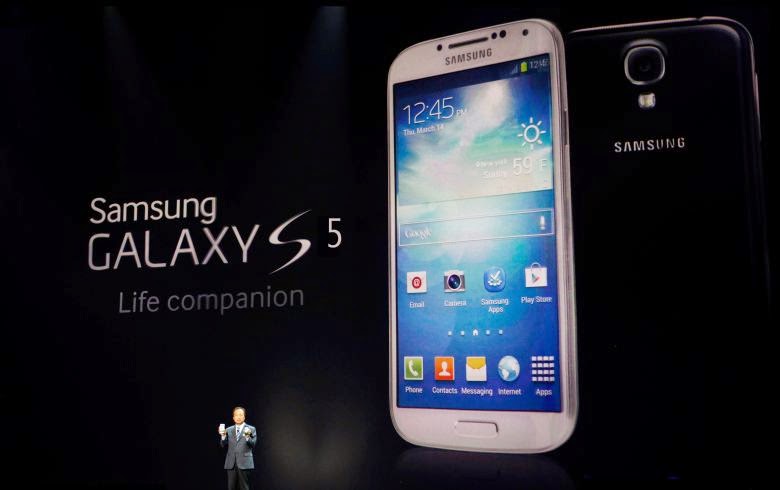The Samsung Galaxy S5 is an Android smartphone produced by Samsung Electronics, which serves as the immediate successor to 2013's Galaxy S4. Unveiled on February 24, 2014 at Mobile World Congress in Barcelona, Spain, it was released on April 11, 2014.
As with the S4, the S5 is an evolution of the prior year's model, placing a particular emphasis on an improved build quality, dust and water resistance, a more refined user experience, new security features such as a fingerprint reader, and an updated camera.
Hardware and design
The design of the S5 evolves upon the design of the S4, with a rounded, polycarbonate chassis carrying a "modern glam" look, faux metal trim, and a removable rear cover. Unlike past models, the S5's rear cover uses a higher quality soft plastic, and is dimpled to improve grip. The S5 is IP67 certified for dust resistance, and for water resistance in up to 1 metre (3.3 ft) of water for up to 30 minutes; as such, the S5's Micro-USB 3.0 port now uses a removable cover. The S5 will be available in black, blue, gold, and white color finishes. The S5's screen is a 5.1-inch (130 mm) 1080p Super AMOLED panel, which is slightly larger than that of the S4, and allows for automatic brightness and gamut adjustments.
Below the screen are three buttons. The physical "Home" button in the centre contains a swipe-based fingerprint reader. The "Recent apps" and "Back" buttons are capacitive. In accordance with Android 4.0 human interface guidelines, the S5 no longer uses a "Menu" key like its predecessors, although its button layout is still reversed in comparison to other Android devices with the S5's button layout (such as the HTC One X and Galaxy Nexus, whose "Back" buttons are to the left of "Home").
The S5 includes a 16 megapixel rear-facing camera, which offers 4K video recording, phase detection autofocus (which can focus in around 0.3 seconds),[4] real-time HDR photos and video, and an image sensor with Samsung's "Isocell" technology, which isolates the individual pixels inside the sensor to improve its ability to capture light. Next to the camera's flash on the rear of the device is a heart rate sensor, which can be used as part of the S Health software.
The S5 is powered by a 2.5 GHz quad-core Snapdragon 801 system-on-chip with 2 GB of RAM. Although not mentioned during the keynote presentation, a variant with an octo-core Exynos 5422 system-on-chip will also be released in unspecified markets. Like the previous model, it uses two banks of four cores; four Cortex-A7 cores at 1.5 GHz, and four Cortex-A15 cores at 2.2 GHz. Depending on resource usage, the SoC can use the power-efficient A7 cores for lighter processing loads, and switch to the A15 cores for more demanding loads. Unlike previous iterations, however, the 5422 can run both sets of cores at the same time instead of only one at a time. For connectivity, it supports 802.11ac MIMO Wi-Fi and LTE.
The S5 contains a 2800 mAh battery; its software also contains an "Ultra Power Saving" mode to further extend battery life; when enabled, all non-essential processes are disabled, and the screen switches to only rendering in white on black. Samsung claims that with Ultra Power Saving on, an S5 with 10% charge remaining can last for an additional 24 hours in standby mode.
Software
The S5 ships with Android 4.4.2 "KitKat" and Samsung's TouchWiz software. Unlike TouchWiz on the S4, the S5's TouchWiz has been given a more refined interface, although certain aspects of the changes were influenced by a recent patent licensing deal with Google, which requires that Samsung's TouchWiz interface follow the design of "stock" Android closer. The S5 adds the Galaxy Note 3's "My Magazine" feature to the leftmost page on the home screen, the Settings menu was updated with a new grid-based layout, a Kids' Mode was added, the "Download Booster" tool allows large downloads to be split across LTE and Wi-Fi to improve speed, while the S Health app was given expanded functionality, integrating with the new heart rate sensor on the device, along with the new Gear 2 smartwatch and Gear Fit activity tracker.
The S5 contains a number of new security features. The fingerprint scanner can be used to unlock the phone, while an SDK is available so third-party developers may offer fingerprint-oriented functionality in their apps; PayPal will integrate support for the fingerprint sensor to authenticate online purchases. The S5 also adds "Private Mode", which allows users to maintain hidden apps and file folders that cannot be accessed without additional authentication. The camera app was updated with a new "Shot & More" menu that allows users to make edits to photos after they are taken, and also adds a new selective focus mode. Samsung has rolled out a minor update on 10th April 2014, one day before the worldwide launch to improve the phone's stability.
Copyrighted by Wikipedia (http://en.wikipedia.org/wiki/Samsung_Galaxy_S5)













